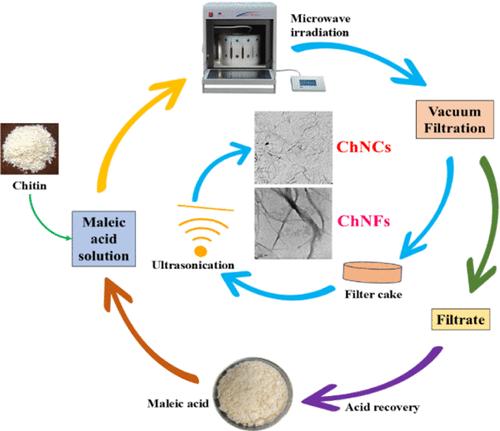当前位置:
X-MOL 学术
›
ACS Sustain. Chem. Eng.
›
论文详情
Our official English website, www.x-mol.net, welcomes your
feedback! (Note: you will need to create a separate account there.)
Facile Green Production of Chitin Nanomaterials from Shrimp Shell Chitin Using Recyclable Maleic Acid and Microwave Irradiation
ACS Sustainable Chemistry & Engineering ( IF 7.1 ) Pub Date : 2024-11-13 , DOI: 10.1021/acssuschemeng.4c06234 Soibam Ngasotter, K. A. Martin Xavier, Layana Porayil, Amjad Khansaheb Balange, Binaya Bhusan Nayak, George Ninan
ACS Sustainable Chemistry & Engineering ( IF 7.1 ) Pub Date : 2024-11-13 , DOI: 10.1021/acssuschemeng.4c06234 Soibam Ngasotter, K. A. Martin Xavier, Layana Porayil, Amjad Khansaheb Balange, Binaya Bhusan Nayak, George Ninan

|
This study presents a facile, green, and sustainable method for the integrated production of chitin nanocrystals (ChNCs) and nanofibers (ChNFs) from shrimp shell chitin using recyclable maleic acid and microwave irradiation. Maleic acid, a mild organic acid, is employed for hydrolysis and functionalization, with 88.5% recovery for reuse, contributing to the sustainability of the process. Optimal production conditions, determined using response surface methodology (RSM), were an 85% acid concentration, 26.63 min of reaction time, and 315.41 W microwave power, yielding 26.28% ChNCs and 64.04% ChNFs. Transmission electron microscopy (TEM) revealed rod-like ChNCs (543.71 nm length, 48.70 nm width) and web-like ChNFs (61.15 nm width). Fourier-transform infrared spectroscopy (FTIR) confirmed successful surface carboxylation, with degrees of substitution of 0.32 for ChNCs and 0.28 for ChNFs. Both nanomaterials exhibited high crystallinity (91.55% for ChNCs, 87.65% for ChNFs), negative zeta potential values (−44.56 mV for ChNCs, −16.93 mV for ChNFs), and enhanced thermal stability compared to raw chitin. The process, evaluated using sustainability metrics, yielded an E-factor of 3.317, highlighting significant waste reduction over conventional acid hydrolysis. This eco-friendly approach aligns with green chemistry principles and offers a sustainable, scalable solution for chitin nanomaterial production, suitable for diverse industrial applications.
中文翻译:

使用可回收的马来酸和微波辐照从虾壳甲壳素中轻松绿色生产甲壳素纳米材料
本研究提出了一种使用可回收马来酸和微波辐照从虾壳甲壳素中集成生产甲壳素纳米晶体 (ChNC) 和纳米纤维 (ChNFs) 的简单、绿色和可持续的方法。马来酸是一种温和的有机酸,用于水解和功能化,88.5% 的回收率可重复使用,有助于该工艺的可持续性。使用响应面法 (RSM) 确定的最佳生产条件为 85% 酸浓度、26.63 分钟反应时间和 315.41 W 微波功率,产生 26.28% 的 ChNCs 和 64.04% 的 ChNFs。透射电子显微镜 (TEM) 揭示了棒状 ChNCs (543.71 nm 长,48.70 nm 宽) 和网状 ChNFs (61.15 nm 宽)。傅里叶变换红外光谱 (FTIR) 证实表面羧化成功,ChNCs 的取代度为 0.32,ChNFs 的取代度为 0.28。与原始几丁质相比,两种纳米材料都表现出高结晶度(ChNC 为 91.55%,ChNF 为 87.65%)、负 zeta 电位值(ChNC 为 -44.56 mV,ChNF 为 -16.93 mV)和增强的热稳定性。使用可持续性指标评估该工艺的 E 因子为 3.317,与传统的酸水解相比,显著减少了浪费。这种环保方法符合绿色化学原则,为甲壳素纳米材料生产提供可持续、可扩展的解决方案,适用于各种工业应用。
更新日期:2024-11-13
中文翻译:

使用可回收的马来酸和微波辐照从虾壳甲壳素中轻松绿色生产甲壳素纳米材料
本研究提出了一种使用可回收马来酸和微波辐照从虾壳甲壳素中集成生产甲壳素纳米晶体 (ChNC) 和纳米纤维 (ChNFs) 的简单、绿色和可持续的方法。马来酸是一种温和的有机酸,用于水解和功能化,88.5% 的回收率可重复使用,有助于该工艺的可持续性。使用响应面法 (RSM) 确定的最佳生产条件为 85% 酸浓度、26.63 分钟反应时间和 315.41 W 微波功率,产生 26.28% 的 ChNCs 和 64.04% 的 ChNFs。透射电子显微镜 (TEM) 揭示了棒状 ChNCs (543.71 nm 长,48.70 nm 宽) 和网状 ChNFs (61.15 nm 宽)。傅里叶变换红外光谱 (FTIR) 证实表面羧化成功,ChNCs 的取代度为 0.32,ChNFs 的取代度为 0.28。与原始几丁质相比,两种纳米材料都表现出高结晶度(ChNC 为 91.55%,ChNF 为 87.65%)、负 zeta 电位值(ChNC 为 -44.56 mV,ChNF 为 -16.93 mV)和增强的热稳定性。使用可持续性指标评估该工艺的 E 因子为 3.317,与传统的酸水解相比,显著减少了浪费。这种环保方法符合绿色化学原则,为甲壳素纳米材料生产提供可持续、可扩展的解决方案,适用于各种工业应用。


















































 京公网安备 11010802027423号
京公网安备 11010802027423号